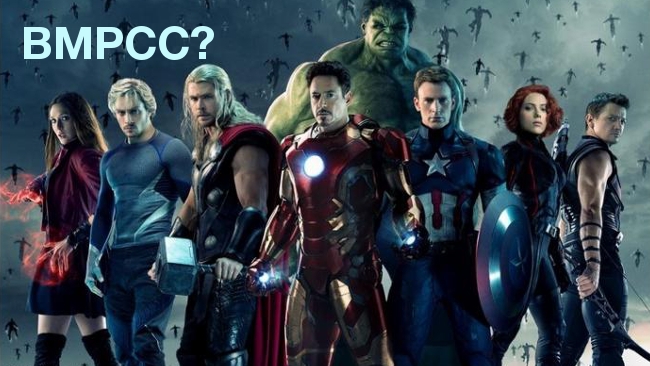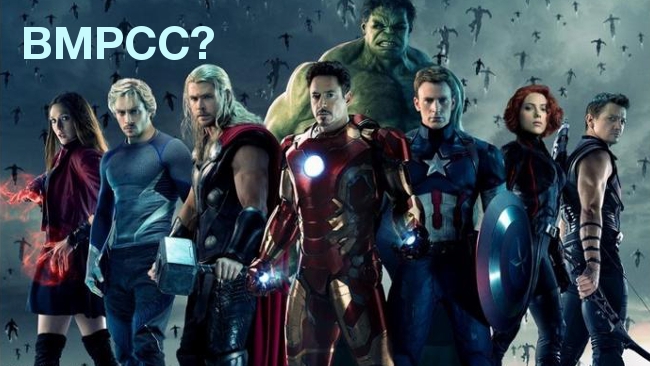
 Avengers: Age of Ultron and the Blackmagic Pocket Cinema Camera
Avengers: Age of Ultron and the Blackmagic Pocket Cinema Camera
Increasingly, cameras small enough to fit in your pocket are making their way onto big budget Hollywood action shoots. Indeed, Ben Davis, DOP on Avengers: Age of Ultron, used eight Blackmagic Pocket Cameras while filming Joss Whedon's superhero extravaganza.
If you don't spend your days on the set of Hollywood action blockbusters, you may think that premium, professional cinema cameras from ARRI, RED or perhaps Panavision (when opting to shoot on film) dominate this field. For the most part, you'd be right. Yet, far away from the A-cam, you may find an assortment of other cameras trained on the action and, sometimes, in the scene but cleverly hidden from view.
While the introduction of the Alexa Mini gives filmmakers an option for a smaller, matching B-cam that will go places the Alexa can't, it's really not that small. And being an ARRI product, its price tag (or the insurance deductible) may preclude a production from putting it in harm's way.
In covering grand-scale action set pieces, such as shootouts, chases or battles, "in harm's way" is often where you need to put a camera. In these situations, what's needed is a tiny, well-built camera with acceptible image quality that's extremely low-cost. In other words, cameras that can hold-up performance wise, relatively speaking, and can take a beating, but that you could essentially treat as expendibles.
Recently, Blackmagic Design interviewed the Director of Photography on Avengers: Age of Ultron, Ben Davis, about the production and the use of Blackmagic Pocket Cinema Cameras as action B-cams. Okay, this is PR, but it's interesting PR and shines a light on the benefits of using cameras such as the BMPCC in this way.
How did you make use of the eight Pocket Cinema Cameras during production? Did they help solve any particular problems or issues for you and how?
Ben: We had a lot of 2nd Unit, a lot of stunt work to do on Age of Ultron and we required a small robust camera. I was a big fan of the work Anthony Dodd-Mantle had done with smaller cameras on Rush, particularly in mounting them in unusual places. So I carried out tests on a number of small camera platforms, however the quality of the image we were getting concerned me. During those tests, I always had in the back of mind that we would be cutting this material in within action sequences, and I had reservations about using the material we were seeing. I then bumped into a DIT friend of mine who’d recently purchased a Pocket Cinema Camera, and he was raving about it, so we pulled one in for testing. For me, it was a non-brainer really, it was all about the latitude and size. Suddenly I saw a small camera which could not only output a 12-bit RAW image, but it also had a latitude that was getting up to and around the level of the Alexa. What I found it akin to was shooting 35mm and then placing 16mm cameras around to capture all of the action shots.
I felt the footage from the Pocket matched incredibly well with our primary camera package, and the added advantage is that I could change the lens and set the lens focus and aperture where we wanted it to be. A lot of the other small camera platforms didn’t have that level of flexibility. It was a fixed lens size and then it would gather its own exposure. They were always a wide angle lens with a fixed focus, which was limiting.
Are there any particular scenes in the film that we should be looking out for where the Pocket was used?
Ben: There are two large battle sequences in the film, the first is at the beginning whilst the second features in the third act, and we very much wanted these to be shot as war footage. So when you watch material filmed by correspondents covering news stories in a war, they’ll put themselves in the line of fire, so you are always hidden behind something and peering out over an obstacle to try and grab the moment. So what we needed was light weight cameras that we could distribute around the set during these battle sequences, and that included eight Pocket Cinema Cameras equipped with a 14mm pancake lens or a 12-35mm zoom, which we mounted to impact points. So for instance, say a truck was being blown up and thrown through the air and was landing on top of a car, we would put one of the Pockets in a small metal housing and put it in the car. Another instance involved mounting Pocket Cinema Cameras to a tank, because you could literally strap one on the end of a magic arm and bolt it to almost anywhere you’d want it to be on the tank because it was so small.
When I got these in I thought they would be a nice to have, however I ended up using these far more than I ever thought we would. The appealing thing about this camera is its size to quality ratio. The footage is usable for a much longer cut time than previous incarnations of small camera platforms. And so the camera does in fact become far more useful. Before, if we thought a shot was worth getting, we’d try and stick a larger camera in to get it, but now we know the Pocket Cinema Camera can cope. It not only has the latitude, but it also has the look and so it becomes a usable shot as opposed to the six to twelve frames we’d been getting from other small camera platforms. And that is why it’s such an appealing camera, it’s size. The Alexa with a lens on it is a big camera, and even the Canon C500 once kitted up becomes a big camera, however suddenly you have something far smaller, and far more versatile. Size really does matter in this instance.
Did you use any specialist rigs?
Ben: No. The whole idea of using the camera was to keep it small and light weight. I really don’t see any point in taking a camera for its size and then strapping 10Ibs worth of accessories to it, it really doesn’t make any sense. Say you were doing a strafing run, we’d put a camera right in the middle of the charges pointing straight at you, and leave it to film. And because of its size the other cameras didn’t see it, and generally they bounced quite well if you put them under an explosion - it’s a remarkably robust camera.
Tags: Production


Comments